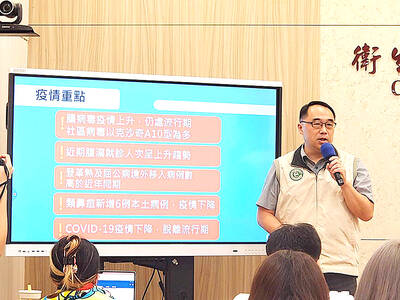Taiwan would have to fight off a Chinese blockade and invasion for about a month before the US could successfully airlift or sealift forces or munitions to support it, war games organized by a US congressional committee on Wednesday showed.
The finding was from a defense industrial base simulation carried out by the US House Select Committee on the Chinese Communist Party (CCP) and the think tank Center for Strategic and International Studies (CSIS).
CSIS defense expert Mark Cancian said Taiwan’s mountainous terrain and two relatively narrow coastal strips make it “a difficult island to capture.”

Photo: CNA
Aside from its terrain, Taiwan’s capital, and most of its industry and military forces are located in the north, he said, adding that this presents China with “a tough choice.”
China could either invade the north, “into the teeth of the Taiwanese defenses,” but also very close to Taipei, or in the south, where it is much easier to get ashore, but “you have to fight your way up the entire island,” he said.
In the event of an attack on the south, China would try to get its forces ashore and quickly capture a port or airfield, while the US and Japan would race to sink Chinese amphibious ships so they could no longer support their forces in Taiwan, Cancian said.
“In most of the [simulations], we won that race, but at a very high cost,” Cancian added.
If Chinese forces did gain a foothold in the south, the resulting campaign would look like Italy in World War II, with Chinese and Taiwanese troops fighting “river line by river line, ridge line by ridge line,” he said.
Alternately, in simulations of an attack on the north, where most of Taiwan’s defenses are, “it ends up being a huge battle outside of Taipei,” Cancian said, adding that it would be “tough” for China to capture the city.
One lesson from the war game was the value of anti-ship missiles, Cancian said.
In the next couple of years, “I think the most effective thing you could do is to give Taiwan 500 Harpoon missiles,” he said.
Such missiles would be stationed in Taiwan and put on mobile launchers; they would be able to hit Chinese ships within range without having to put US troops on the ground, he said.
“The other lesson is that once the fighting begins, it’s impossible to get any forces or reinforcements onto Taiwan,” Cancian said.
Since Chinese forces would surround Taiwan, the US would not be able to get an airlift or sealift to the nation “at least for the first three or four weeks,” he said.
“Taiwan would have to fight at least the first month, and maybe the first two months, with whatever it starts out with,” he added.
The war simulation was also attended by US House Select Committee on the CCP Chairman John Moolenaar, ranking member Raja Krishnamoorthi and Armed Services Committee Vice Chairman Rob Wittman.
In April, Wittman was one of four US representatives who sent a letter urging the US House Appropriations Committee to allocate US$165 million to expedite the delivery of Harpoon missiles to Taiwan.
The lawmakers said the missiles should be delivered within the “Davidson window,” a term referring to the 2021-to-2027 period when former US Indo-Pacific Command head Admiral Phil Davidson believed a Chinese invasion of Taiwan would be most likely.
Last year, Bloomberg reported that Taiwan had purchased 400 land-launched Harpoon missiles from the US, completing a deal that the US Congress approved in 2020.
The Chinese-language Liberty Times (sister paper of the Taipei Times) in September reported that Taiwan had received an unspecified number of Harpoon missiles, part of a total of 128 missiles and 32 launchers that would be delivered by the end of 2026.
However, in Wednesday’s exercise, Wittman said that there is “no way” the US could catch up with China’s industrial capacity by 2027.
China has a shipbuilding capacity 232 times greater than the US, as well as advantages in producing regular and long-range munitions, he said.
The US should therefore not view “exquisite” weapons platforms — costly, advanced weapons produced in small numbers — as the solution, and should instead focus on contingency strategies that could be more effective in the near term, he added.

A magnitude 4.9 earthquake struck off Tainan at 11:47am today, the Central Weather Administration (CWA) said. The hypocenter was 32.3km northeast of Tainan City Hall at a depth of 7.3km, CWA data showed. The intensity of the quake, which gauges the actual effect of a seismic event, measured 4 in Tainan and Chiayi County on Taiwan's seven-tier intensity scale, the data showed. The quake had an intensity of 3 in Chiayi City and County, and Yunlin County, while it was measured as 2 in Kaohsiung, Nantou County, Changhua County, Taitung County and offshore Penghu County, the data showed. There were no immediate reports of

Weather conditions across Taiwan are expected to remain stable today, but cloudy to rainy skies are expected from tomorrow onward due to increasing moisture in the atmosphere, according to the Central Weather Administration (CWA). Daytime highs today are expected to hit 25-27°C in western Taiwan and 22-24°C in the eastern counties of Yilan, Hualien, and Taitung, data on the CWA website indicated. After sunset, temperatures could drop to 16-17°C in most parts of Taiwan. For tomorrow, precipitation is likely in northern Taiwan as a cloud system moves in from China. Daytime temperatures are expected to hover around 25°C, the CWA said. Starting Monday, areas

The Chinese Nationalist Party (KMT) is maintaining close ties with Beijing, the Democratic Progressive Party (DPP) said yesterday, hours after a new round of Chinese military drills in the Taiwan Strait began. Political parties in a democracy have a responsibility to be loyal to the nation and defend its sovereignty, DPP spokesman Justin Wu (吳崢) told a news conference in Taipei. His comments came hours after Beijing announced via Chinese state media that the Chinese People’s Liberation Army’s Eastern Theater Command was holding large-scale drills simulating a multi-pronged attack on Taiwan. Contrary to the KMT’s claims that it is staunchly anti-communist, KMT Deputy

Taiwan has recorded its first fatal case of Coxsackie B5 enterovirus in 10 years after a one-year-old boy from southern Taiwan died from complications early last month, the Centers for Disease Control (CDC) said yesterday. CDC spokesman Lo Yi-chun (羅一鈞) told a news conference that the child initially developed a fever and respiratory symptoms before experiencing seizures and loss of consciousness. The boy was diagnosed with acute encephalitis and admitted to intensive care, but his condition deteriorated rapidly, and he passed away on the sixth day of illness, Lo said. This also marks Taiwan’s third enterovirus-related death this year and the first severe